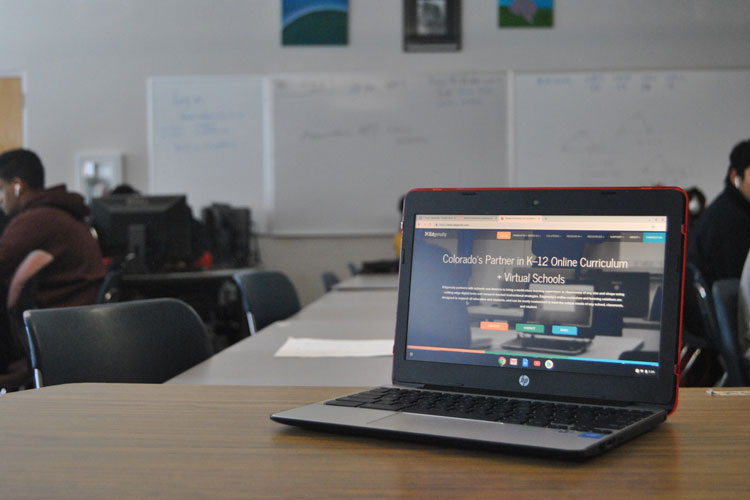
Students can be in their classrooms anywhere that they have internet access. photo by Logan Cecil
The Credit Recovery class at TJ makes strides in helping students achieve their goals and succeed in their educational careers.
School is hard. Sometimes no matter the effort put into a subject, it is difficult to make headway into bringing up a grade. And while failing a class is never something that should be celebrated, it is nice to know that TJ has some of the best credit recovery instructors and courses in the district. Teachers Jill Spivey and Beth Kellim run the Edgenuity program at Thomas Jefferson, the online platform that Spartans can use to earn or recover credits, and they have helped make strides in the performance of the program over the past few years.
Traditional schooling does not always work for everyone. For some, a self-structured path that allows for a more dynamic agenda is more appealing. This is by no means something that should be frowned upon, as technology is a tool and should be utilized to maximize the opportunities of which can be taken advantage.
Edgenuity allows students to complete or recover their credits through original or unit recovery. Original credit courses lets students who never took a class, but need it to graduate, to earn the credits they need without giving up another class or off period. Unit recovery lets a student who did not earn the credit from one of their classes to regain it, moving forward with the credits they would of had if they passed the class the first time. This champions the students ability to control the time, pace, path, and place of their education. In terms of time, the student can essentially access their ‘classroom’ at any time, allowing them to mold their workload around their personal schedule. Pace refers to how a student can get their work done on their own time table, not necessarily all at once. Path regards how the teachers overseeing the progress of their students can individualize the curriculum to their kids’ needs. Lastly, place references how a student can get their work done from any location in which they have computer and internet access. All of these facets allow for a student to succeed at their own discretion, regardless of circumstance.
While this does not eliminate the necessity of a teacher’s presence in the classroom, it allows students to develop their own understanding of a subject while still having the guiding hand of an educator should they need it. Spivey and Kellim serve that duty in their classes, giving students help with their work in vast ranges of subjects. Last year, they managed to bring the number of seniors who took credit recovery courses and did not graduate all the way down to zero, an impressive stat that was a vast improvement from years past. In addition to the number of seniors who finished their work, 26 juniors completed 36 classes and 24 sophomores completed 29 of their classes, all of whom are now on the path to graduating with their classmates.
In some scenarios, students decide to transition to different schools that offer more sound coursework for their needs and give them opportunities to flourish, as every student should. Generally, the experience is extremely positive. As Spivey recollected, “When kids who have transitioned come back to visit, it is wonderful. They say things like ‘Oh my gosh, I feel so successful in my new school!’”
All in all, the process is designed to make it as easy as possible for the student to get their credits in order so that they can graduate on time. In describing the program, Spivey said, “Generally, we have had a really good success rate. TJ is very much a village and everyone contributes to the encouragement that these students need to succeed.”